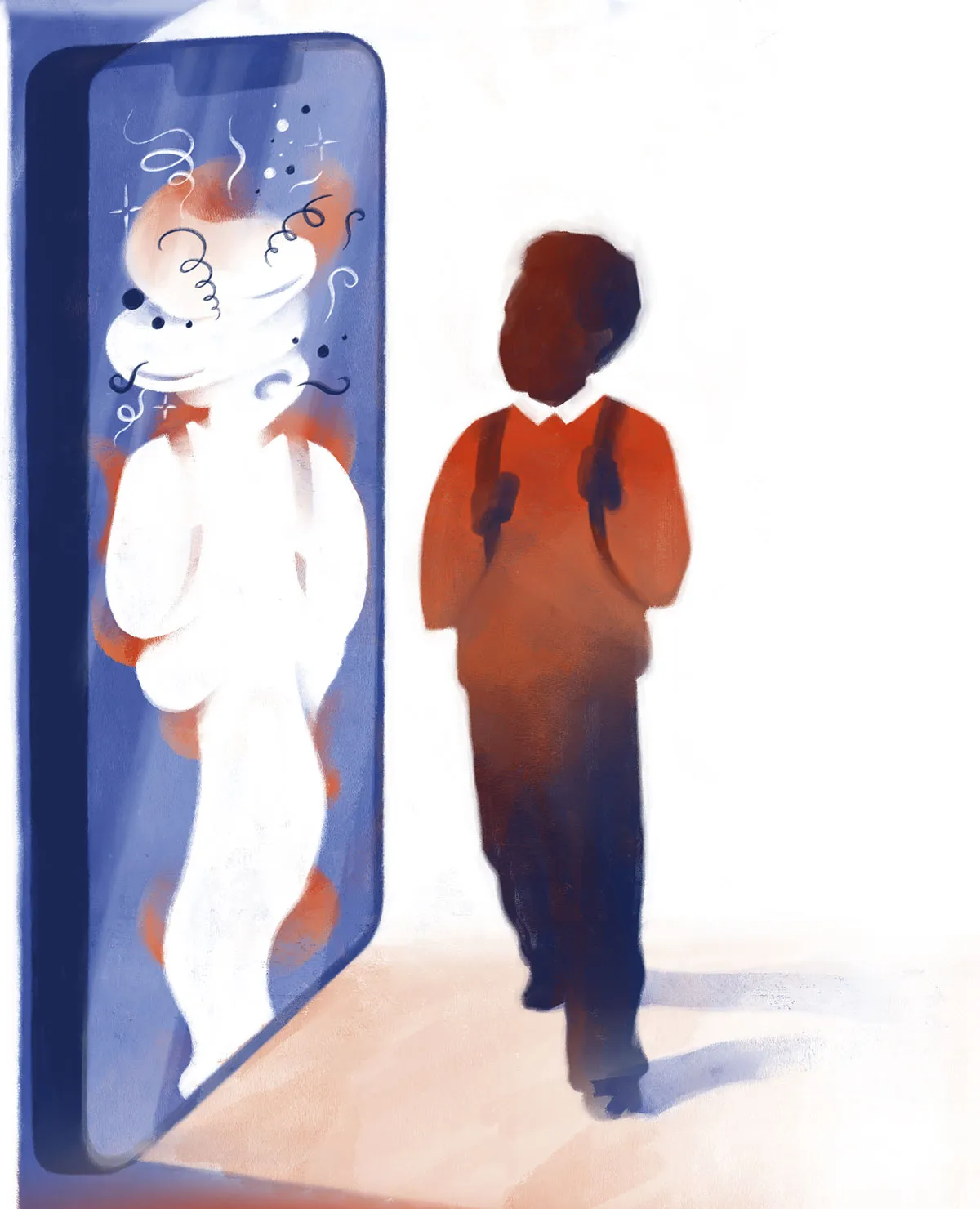What do we really know about the relationship between social media and teenage mental health?
I ask because the other day, my daughter asked me if she could have her own phone. She’s only three years old, so the request caught a little off guard. This wasn’t a conversation I was expecting to have until she becomes a teenager.
"You’re too little to have a phone yet," I said to her. "Why do you want one?"
No clear reason was forthcoming, save for a beautiful stream of consciousness that one of her friends at nursery had a friend at school who was four and had a phone, and because three is nearly four could she, my daughter, have one.
I gently explained to her that this is something we could talk about when she was older, and although not quite content with an answer that was essentially ‘no’, she wandered off to start her next adventure of the day.
That conversation left me with two feelings. One was a slight air of confusion – what sort of phone had we been talking about? I had assumed it was a smartphone and I was wracking my brains to come up with a reason why a four-year-old might need one.
But maybe we’d just been talking about a toy, in which case, my daughter already had a phone – many, in fact, if you include things like bananas, pens and the shower attachment on our bath.
The other feeling was unease. Digital technology is a necessary part of our lives – smartphones, social media, even video games are the primary ways we interact and connect with people.
And while it’s inevitable that our kids will join that digital space, for many of us, those technologies are a sort of Pandora’s box. There’s something about them that feels bad and so providing access to them, while it might have some benefits, feels like a disaster waiting to happen.
These fears are driven, in part, by a seemingly relentless parade of articles in the news highlighting the detrimental effects that digital technologies have on us. But such articles mesh with our own experience, because we’ve all had bad days online.
It’s easy – and understandable – to feel that screen technologies just haven’t got our wellbeing at heart.

Reinforcing this sense of unease is the fact that there are some real causes for concern about mental health, particularly when it comes to children and adolescents.
Across a range of recent scientific studies, the trends seem clear: over the past decade or so, there has been a noticeable increase in mental health issues in UK and US teenagers.
For example, a 2021 study of patient data from nearly 2.5 million UK teens showed that for nearly every age group, anxiety and depression rates have been increasing, with a particularly striking increase in anxiety disorder rates for girls aged 13-19 that seems to start around 2012.
Further data from the US-based Youth Risk Behaviour Survey (YRBS) points to similar concerns: on average, there have been steady increases in both depression and suicide risk since 2011, with rises being much more pronounced in girls than in boys. Something seems to be going seriously wrong with teenage mental health.
What’s to blame for our mental health crisis?
Trying to pinpoint exactly what’s causing these issues isn’t easy but over the past few years a number of psychologists and journalists have focused on digital technology – in particular, social media – as the driving factor.
Perhaps the most prominent example of this was in 2017, when, in an article published in The Atlantic, psychologist Dr Jean Twenge suggested that the points at which we start to see steeper rises in various measures of poorer mental health appear to coincide with the advent of the iPhone, around 2007.
It’s a compelling point: if you produce a graph plotting, for example, the percentage of US teens who agree with the statement "I often feel left out", and then draw a vertical line through 2007, the data look fairly flat prior to that point, and then skyrocket afterwards. The same is broadly true for other similar statements, as well as overall depression scores.
The article, titled ‘Have smartphones destroyed a generation?’, was one of the most widely shared science opinion pieces that year and has had an influential effect on the wider debate about the relationship between digital technology and mental health ever since.
So much so, that we saw a similar argument made in the Financial Times recently – although this time, the headline was much more assertive (‘Smartphones and social media are destroying children’s mental health’), and the trendline graphs were segmented into pre- and post-2010, which was loosely labelled as ‘the smartphone era’.
Read more:
- Today's social media is a dumpster fire, but scientists are building something better from scratch
- Why scientists don’t actually know if social media is bad for you
- Content moderators pay a psychological toll to keep social media clean. We should be helping them
Building bias
Scary headlines like this are unhelpful for two reasons. The first is that because of a lack of consistency in research findings, we don’t know whether the worries they stoke are proportionate or directed appropriately.
The second is that they risk feeding into what researchers call ‘the influence of presumed influence’ (that is, because we’re repeatedly exposed to news stories telling us that screens are bad for us, it becomes the assumption that drives our behaviours and attitudes towards them and, potentially, our responses in studies asking us to report on our digital behaviours – as opposed to our actual experiences).
So, while research and the associated public discussion have trudged on since then, unfortunately, we haven’t made much headway in terms of more deeplyunderstanding the relationship between social media and mental health.
Some studies do find clear links, others don’t; some find links but only in some situations and sometimes, different studies find different results even though they’re based on the same data.
Part of the reason for that is that most studies in this area are necessarily correlational in nature – they take big long-term datasets, like the YRBS, and try to see whether there are any statistically significant relationships between the rise in social media, say, and different measures of mental health.
But while these sorts of datasets are hugely powerful entities, they don’t allow us to get any closer to understanding whether those relationships are causal in nature.
And as to why we find such disparate findings, research published in 2019 suggests that whether or not we find correlations in the data has more to do with how researchers’ biases influence data analysis, as opposed to whether there’s an actual signal in the data.
The study, from the Oxford Internet Institute, showed that in datasets like the YRBS, there are a huge number of questions that are asked about digital technology use, wellbeing and other factors that can impact both.

It’s what makes these sorts of surveys so powerful from a scientific perspective: because of the vast amount of data they collect, you can ask questions about almost any aspect of human behaviour.
But it also means that the number of sensible and theoretically justifiable ways in which you can combine measures of tech use and wellbeing to ask a meaningful question about how they’re linked can, in some cases, run into the trillions.
Without due care and attention then, researchers may unwittingly fall into the trap of running multiple analyses until they ‘find’ the answer they think they wanted in the first place.
That means it’s incredibly important to have a sound theoretical base for asking those questions in the first place, which is something we don’t really have at the moment.
It’s a fact that speaks to a more fundamental issue, one that both researchers and journalists need to address before we can make any progress in understanding what’s going wrong for teenage mental health.
That issue, I think, is that we’re asking the wrong questions about the role that digital technology and social media have to play.
Correlation is not causation
It’s hard not to get seduced by the figures published in the Atlantic piece in 2017, and in the Financial Times earlier this year – there’s so clearly a shift in mental health issues around 2007-2010 that there must be a causal connection with the advent of smartphones. But we need to be wary of coincidences.
But 2007 also saw the onset of a global financial crisis, as well as the launch of the Foo Fighters’ album Echoes, Silence, Patience & Grace. One of these things makes sense to consider in the context of long-term effects on mental health; the other doesn’t.
But we could quite happily draw a line through 2007 on a graph of mental wellbeing, label it as either ‘financial crisis’ or ‘Foo Fighters’ and infer a link.
We need to be mindful, then, that mental health issues are complex and nuanced, and are therefore never going to be explained by a single, simple factor (or multiple factors that are all referred to interchangeably – smartphones and social media are very different things).
Alongside the rise in social media use, other possible factors that have been cited in the literature include: increases in parental mental health issues; reductions in stigmatising attitudes and behaviours towards mental ill health; a general increase in awareness about their existence; changes in diagnostic criteria; financial difficulties; educational stressors; and more.
So instead of asking, "Does social media use cause mental health issues?" perhaps a better question might be: why do some people prosper online while others get into real difficulty?

There’s growing research evidence that suggests our online lives reflect our offline lives in important and sometimes indiscernible ways – that they’re not separate entities.
In other words, things that are happening in our offline lives can both affect and be affected by our online world.
For example, a number of studies have shown that teenagers’ online and offline social networks are very similar – they use social media and online messaging services mainly to navigate their existing relationships, not to forge new ones.
Moreover, an emerging line of research suggests that the types of mental, physical and social issues that exist in children’s lives can predict the types of problems they encounter online.
For example, work published in 2018 showed that children with physical disabilities or communication difficulties were more likely to engage in ‘conduct’ risks (say, visiting gambling websites or illegally downloading music), whereas teenagers with family or social issues were more likely to fall victim to online scams.
What we’re starting to see as the research matures, is the idea that it doesn’t make sense to consider social media and digital technology as a root cause of mental health issues.
Instead, it’s more useful to consider them as a lens through which pre-existing issues and inequalities are either dampened or intensified. They’re part of a wider ecosystem of interrelated and reciprocal factors that affect our resiliency and mental health.
Why we need to look at the bigger picture
The way teenagers use social media, then, can both affect their mental health, but also be affected by it, and how problematic that resulting effect can depend on a huge range of factors – things like what their online and offline social support networks look like, the extent to which parents and caregivers are able to provide scaffolding for their online experiences, and even age and socioeconomic status.
Recent research led by Dr Amy Orben at Cambridge University, for example, has suggested that there are critical windows of sensitivity to social media use in adolescence, and these vary by sex and age.
For girls, one of the key critical periods seems to be around the ages of 11-13. Increases in self-reported social media use in this age group seem to reliably predict decreases in life satisfaction around a year later, which Orben and her team have argued may be linked to the earlier onset of puberty in females.
There’s a similar critical window at around age 19 for both sexes, which tends to coincide with moves away from home and disruption to pre-existing social networks.
There’s no doubt that younger generations have been experiencing an upheaval in terms of their mental health over the past decade and more.
If we truly care about understanding why that has happened, and doing something that will make a meaningful difference, then we need to move away from simplistic, scaremongering narratives that place the blame solely on a single source. To do so inevitably leaves us with a single, unrealistic solution: restriction.
Digital technologies aren’t going to go away though, and if we restrict their access in the wrong way, we remove the potential for children and adolescents to develop much-needed skills and competencies, alongside an important source of social connection.
My daughter hasn’t asked for a phone again since that initial conversation. Maybe it was just a passing thought; maybe she had actually just been talking about a toy.
I’m fully aware that it’s a topic of debate that will come up again with her in the future, though, as it will for many people in my position. So if we want to empower parents to have better conversations about how best to maximise the benefits and minimise the risks of online life, the public debate about screens needs to be approached differently.
In that regard, both journalists and researchers have a duty to start approaching the issue with the level of maturity, rationality and objectivity that it so desperately needs.
Read more:
